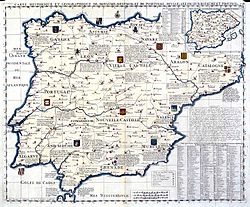Day of Zamora: Difference between revisions
No edit summary |
|||
| Line 28: | Line 28: | ||
{{History of Spain}} |
{{History of Spain}} |
||
After the victory, the chronicles describe how the Asturian defenders severed the heads of Muslim leaders and posted them on spikes on the battlements of the city walls for all to see. A portion of the wall south of the city's main cathedral lies next to a street called [[Calle Balborraz]] (named for an old gate exiting the city called the [[Puerta de Balborraz]]). This denomination originates from the arab word ''bab al ras'' where ''bab'' means door and ''ras'' means |
After the victory, the chronicles describe how the Asturian defenders severed the heads of Muslim leaders and posted them on spikes on the battlements of the city walls for all to see. A portion of the wall south of the city's main cathedral lies next to a street called [[Calle Balborraz]] (named for an old gate exiting the city called the [[Puerta de Balborraz]]). This denomination originates from the arab word ''bab al ras'' where ''bab'' means door and ''ras'' means head.<ref>{{cite book |author= Francisco Javier Rodríguez Méndez |title= Plan Director de las Murallas de Zamora |otros= |edición= |year= 2006 |editor= Junta de Castilla y León |publisher= Actas del IV Congreso Internacional "Restaurar Memoria" |location= Valladolid |isbn= 84-9718-360-6 |capítulo= |páginas= |cita= }}</ref><ref name="TrZ">{{cite book |last= De Dios Vega |first= Carmelo |title= Zamora de Ayer y de Hoy |edition= 1 |year= 1959 |editor= Talleres Tipográficos "Heraldo de Zamora" |editorial= |location= Zamora |isbn= |capítulo= |pages= 133-134 }}</ref><ref name="HFZ">{{cite book | author = Hernández Martín, Joaquín | title = Guía de arquitectura de Zamora. Desde los orígenes al siglo XXI | year = 2005 -2ª edición- | publisher = Colegio Oficial de Arquitectos de León | id = ISBN 84-607-9629-9}}</ref> |
||
The Hispano-Muslim chronicles of this battle also mention the presence of [[Ibn Hayyan]]. According to the chronicles written by [[Ahmad ibn Muhammad al-Razi]], the attack is attributed to the [[Shia Islam|Shia]] movement under the authority of the "prophet" [[Ibn al-Quitt]]. |
The Hispano-Muslim chronicles of this battle also mention the presence of [[Ibn Hayyan]]. According to the chronicles written by [[Ahmad ibn Muhammad al-Razi]], the attack is attributed to the [[Shia Islam|Shia]] movement under the authority of the "prophet" [[Ibn al-Quitt]]. |
||
== See also == |
== See also == |
||
Revision as of 10:19, 30 May 2012
| Battle of Alhandic | |||||||
|---|---|---|---|---|---|---|---|
| Part of the Reconquista | |||||||
 The walls of and trenches at Zamora. | |||||||
| |||||||
| Belligerents | |||||||
|
| Caliphate of Córdoba | ||||||
| Commanders and leaders | |||||||
|
| Ahmed-ben-Moavia | ||||||

The Day of Zamorra (Spanish: Día de Zamora), also known as the Jornada del Foso de Zamora or the Fight for the trenches of Zamora, was a battle of the Spanish Reconquista that took place at the city of Zamora, Spain[1] The battle was fought between the forces of the Kingdom of Asturias under the command of Alfonso III of Asturias and the Muslim forces of Ahmed-ben-Moavia (AKA: Abul Kassin). The battle ended with in victory for the city's defenders.
The Battle
The troops of Ahmed-ben-Moavia surrounded the city of Zamora in July of 901, quickly assaulting the renowned walls of the city. The battle lasted four days, finally resulting in victory for the city's Christian defenders.
The Arab chronicles of the time recounting the battle describe the amount of dead and injured as so great that it is referred to as the Jornada del Foso de Zamora, or the battle for the pit of Zamorra (Not to be confused with the Battle of Alhandic 939, which bears the same nickname).[2][3]
| History of Spain |
|---|
 |
| Timeline |
After the victory, the chronicles describe how the Asturian defenders severed the heads of Muslim leaders and posted them on spikes on the battlements of the city walls for all to see. A portion of the wall south of the city's main cathedral lies next to a street called Calle Balborraz (named for an old gate exiting the city called the Puerta de Balborraz). This denomination originates from the arab word bab al ras where bab means door and ras means head.[4][5][6]
The Hispano-Muslim chronicles of this battle also mention the presence of Ibn Hayyan. According to the chronicles written by Ahmad ibn Muhammad al-Razi, the attack is attributed to the Shia movement under the authority of the "prophet" Ibn al-Quitt.
See also
- Battle of Alhandic - The battle of the same nickname which took place outside the city walls in 939 and resulted in Muslim victory.
- Zamora, Spain
- Alfonso III of Asturias
- Reconquista
References
- ^ Cesáreo Fernández Duro , (1882), Memorias Históricas de la ciudad de Zamora, su provincia y obispado, Madrid, Sucesores de Rivadeneyra, T. I, pp. 192-193.
- ^ Álvarez Martínez, Ursicino (1965). Historia General Civil y Eclesiástica de la Provincia de Zamora (1 ed.). Madrid: Editorial Revista de Derecho Privado.
{{cite book}}: Unknown parameter|coauthor=ignored (|author=suggested) (help) - ^ Felipe Maíllo, (1990), Zamora y los zamoranos en las fuentes arábigas medievales, Salamanca , recogido por Fernando Luis Corral, Zamora. De las crónicas al romancero, Salamanca 1993, pp. 26 y 28
- ^ Francisco Javier Rodríguez Méndez (2006). Junta de Castilla y León (ed.). Plan Director de las Murallas de Zamora. Valladolid: Actas del IV Congreso Internacional "Restaurar Memoria". ISBN 84-9718-360-6.
{{cite book}}: Cite has empty unknown parameters:|edición=,|otros=,|páginas=,|cita=, and|capítulo=(help) - ^ De Dios Vega, Carmelo (1959). Talleres Tipográficos "Heraldo de Zamora" (ed.). Zamora de Ayer y de Hoy (1 ed.). Zamora. pp. 133–134.
{{cite book}}: Cite has empty unknown parameters:|editorial=and|capítulo=(help)CS1 maint: location missing publisher (link) - ^ Hernández Martín, Joaquín (2005 -2ª edición-). Guía de arquitectura de Zamora. Desde los orígenes al siglo XXI. Colegio Oficial de Arquitectos de León. ISBN 84-607-9629-9.
{{cite book}}: Check date values in:|year=(help)CS1 maint: year (link)
